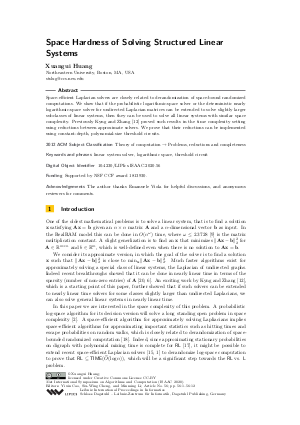LIPIcs.ISAAC.2020.56.pdf
- Filesize: 0.59 MB
- 12 pages

 Creative Commons Attribution 3.0 Unported license
Creative Commons Attribution 3.0 Unported license

Space-efficient Laplacian solvers are closely related to derandomization of space-bound randomized computations. We show that if the probabilistic logarithmic-space solver or the deterministic nearly logarithmic-space solver for undirected Laplacian matrices can be extended to solve slightly larger subclasses of linear systems, then they can be used to solve all linear systems with similar space complexity. Previously Kyng and Zhang [Rasmus Kyng and Peng Zhang, 2017] proved such results in the time complexity setting using reductions between approximate solvers. We prove that their reductions can be implemented using constant-depth, polynomial-size threshold circuits.

Feedback for Dagstuhl Publishing